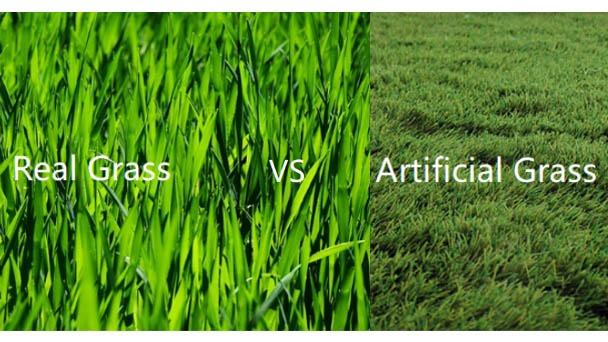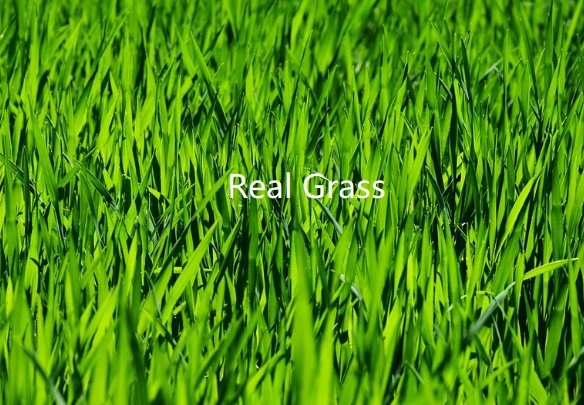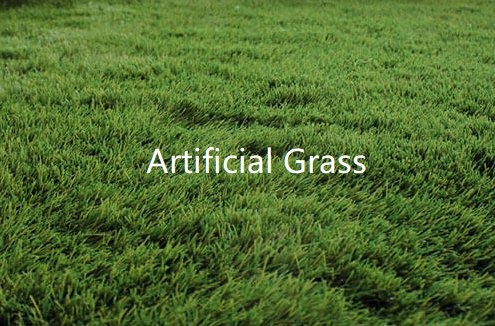Real Grass vs Artificial Grass - Differences & How to Choose
Written by Ivy
Dec 28 2022

You can choose the type of grass that is best for your property and way of life by understanding the benefits and drawbacks of real grass vs. artificial grass.
Real Grass Overview

Grass that has been grown from sod or grass seeds is considered real grass. Sod is a roll of grass and soil that resembles a rug and is spread out so it can grow into your lawn. It is held together by netting or cut grass stems.
Artificial Grass Overview

Artificial grass is a surface made of synthetic grass blades that mimics real grass in appearance. There are a few different names for artificial grass, including fake grass, plastic grass, astroturf, and turf. These names primarily all refer to the same product, artificial grass.
The Difference Between Artificial Turf and Real Grass
Real grass vs. artificial grass is a topic of discussion that has been around for a while. When picking your grass, take into account the following elements.
Drought Tolerance
This refers to a plant's capacity to endure dry conditions. Drought-resistant plants are challenging to keep alive due to the recent severe droughts that the nation has experienced.
-
Artificial Grass:
The fact that this alternative doesn't require water is one of its greatest benefits. This will give you a green lawn all year long as stricter water restrictions are put in place.
-
Real Grass:
Although some grass species can withstand droughts, they still require water to survive. Smaller lawns that use less water are better suited for this option.
Shade Tolerance
This is a plant's capacity for surviving in locations with less sunlight. Several rainstorms occur in the nation during the wet season despite the recent droughts.
-
Artificial Grass:
Although this type of lawn can survive without sunlight, it retains more heat than actual grass does. In the summer, it is uncomfortable to walk barefoot on this.
-
Real Grass:
A variety of grass species can tolerate some shade. For instance, zoysia is well known for surviving the winter.
Foot Traffic
Use of your lawn is intended. However, frequent foot traffic could lead to bare spots and discoloration. To ensure your grass lasts a long time, pick a variety that can withstand your way of life.
-
Artificial Grass:
Because of its famed durability and capacity to withstand high foot traffic, synthetic grass is frequently used in commercial lawns.
-
Real Grass:
Several hardy grass varieties, including Zoysia and Kikuyu, can withstand the active way of life in your household.
Safety
You should pick a secure grass type because your children and pets will be on the lawn quite a bit.
-
Artificial Grass:
It doesn't develop the dips and humps that raise the possibility of tripping and falling. But low-quality knockoffs might contain toxic residue that washes off during rain.
-
Real Grass:
When kept up, it provides your children and animals with a plush surface on which to play. But to stop the spread of these pests, you must regularly check it for pests.
Maintenance
Your lawn's longevity, condition, and functionality all depend on how well you take care of it. Select a grass type that is inexpensive to maintain, easy to maintain, and won't cause issues in the future.
-
Artificial Grass:
There is a misconception that this option doesn't need maintenance, but it is still susceptible to the accumulation of dirt, dust, and odors. To maintain the surface's condition, you must clean and wash it with water.
-
Real Grass:
The species you decide to plant will affect maintenance. Typically, to maintain this lawn's beauty and greenness, you must water, mow, and remove weeds. To ensure growth, you might also need to apply fertilizer.
Living Space
Living space includes the area of your home where a lawn will be installed. Some homebuilders lay out lawns before setting furniture on top of them. You must decide whether natural or artificial turf is better for the space, depending on its intended use. As was already mentioned, choosing artificial turf is preferable if you intend to place couches, bean bags, tables, or lawn chairs. You don't want unsightly bald patches of grass caused by using furniture on natural grass.
Installation
The installation process should be taken into account from various angles. First of all, installing artificial grass is much simpler and requires fewer workers. For your lawn to grow beautifully, natural grass is more complex and demands the utmost care. Artificial grass is quicker to install than natural grass as a result of this distinction. Compared to artificial grass, which only requires rolling out the turf and can be used immediately, natural grass requires more downtime. For homeowners who don't have a lot of time to wait for a new lawn, artificial grass is ideal because it requires less soil preparation and watering.
Resilience and Durability
The health of a lawn is crucial. It is even better when a lawn continues to feel and look good over time. Because of this, it's essential to base your lawn selection on its resilience and durability. Because you don't have to worry about giving it as much care as other less durable types, a durable turf will save you a lot of money and energy. You can choose between artificial and natural grass in this situation. In general, synthetic turf is more resilient than real grass. The resilience of some natural grass varieties, however, can rival that of synthetic turf. Whether you want actual living grass on your property or not is what it comes down to in terms of durability and resilience.
Artificial Grass Maintenance
How to Maintain a Real Grass Lawn
The worst thing you can do is neglect your lawn because it will cost you more money to clean it up. Maintaining your lawn regularly (or switching to artificial grass) is the best way to prevent this.
- During the summer months, deeply water your lawn.
- Mow often with lawn mower
- Fertilize your lawn often
- Aerate your yard in fall or spring
How to Maintain An Artificial Grass Lawn
Simple and time-free maintenance is available for artificial grass. Do more than simply cut your grass; enjoy it.
- Utilize a leaf blower, stiff brush, or plastic rake on a regular basis to clear away leaves and other debris.
- Apply weed killer approximately twice a year
- Use an artificial grass deodorizer spray to clean away any urine from your pets (as needed)
The aesthetic distinctions between a lawn with artificial grass and one with real grass.
Real Grass
Because the color, texture, and height of the blades vary depending on outside factors like the season, real grass does not appear as flawless as artificial grass.
Artificial Grass
Artificial grass is consistently picture-perfect and ready for photos. All year long, the blades are the same height and color. Artificial grass is frequently chosen by those who need a perfect front lawn all year long.
Artificial Grass Cost
Real grass and artificial grass have different initial costs in addition to having different maintenance requirements.
Real Grass
Real grass lawn sod rolls range in price from 35 cents to 99 cents per square foot plus $1 to $2 per square foot for installation. Spend no more than $2.5 per square foot to have a new lawn installed.
Mowing, fertilizing, and watering incur additional costs. You will have a very high water bill after watering your natural grass. You'll need to spend 30 minutes each week mowing.
Artificial Grass
Artificial grass installation costs are initially significantly higher. Installation of artificial grass ranges from $5 to $20 per square foot, but real grass maintenance costs are much higher.
You won't have a water bill, you can sell your lawnmower, and maintaining artificial grass takes much less time.
Artificial grass has a higher initial cost with much lower on-going maintenance costs than real grass, which has high initial costs and low ongoing maintenance costs.
Artificial Grass Environmental Impact
Real Grass
Real grass is mowed with gas lawn mowers, which release harmful airborne pollutants. Your natural grass thus contributes significantly to air pollution and noise pollution. A gas lawn mower is frequently up to 40 times more environmentally damaging than leaving your car running for the same amount of time, depending on the type of mower you use.
Artificial Grass
Due to the lack of mowing requirements, artificial grass does not have this impact on the environment.
Since artificial grass is manufactured as opposed to real grass, it frequently receives a bad rap from the general public. While some artificial grass is made from recycled tires for automobiles, these tires are not biodegradable on their own. Plastic that would otherwise be useless is given a new use by artificial grass, keeping it out of landfills.
Real grass can provide a cooling effect when it's extremely hot outside, especially at higher elevations. This effect is also produced by artificial grass, which is also cooler in temperature than real grass. Bella Turf Artificial Grass produces some of the most realistic, low-maintenance grass available when combined with PureZEO Pro Infill.
Real Grass Vs. Fake Grass: Which Should You Choose for Your Lawn?
Some passionate gardeners enjoy mowing the lawn on a sunny Sunday afternoon as much as they enjoy caring for and maintaining their garden and taking pride in its appearance.
However, if you're open to the idea of a free weekend, more cash in your pocket, and lean toward a "set it and forget it" landscaping option, artificial turf is for you.
Artificial grass is a great option if you live in a dry climate, are busy with work, family, and travel, or both.
Summary
Although both artificial grass and a real grass lawn have advantages, for some people artificial grass might offer enough advantages to be worth consideration.
If you can afford the luxury of artificial grass, it is definitely something to think about. Artificial grass has been carefully developed over the years to be superior to real grass lawns.
FAQs
What is Cheaper Grass Or Turf?
From the comparison above, the cost of natural grass over time ends up being the more costly option. In three to five years, the initial expense of artificial turf will be equivalent to that incurred for the installation and upkeep of a natural grass lawn.
Artificial Grass Vs Real Grass Temperature
Surface temperatures of artificial grass are about 20-50° F higher than natural grass and typically reach the same temperature as asphalt pavement. During the research, a temperature of 200°F was recorded as the highest.
Fake Grass Vs Real Grass for Dogs
Artificial grass is generally safer for dogs, too. For instance, if your dog consumes or is simply exposed to grass that has been fertilized or treated with pesticides, they may become ill. It is safer for your dog to play on artificial turf because it doesn't require any of those chemicals.
Why is Real Grass Better Than Fake Grass
The environment benefits greatly from real grass. An area of real grass measuring 2,500 square feet produces enough oxygen for a family of four to breathe. A fairway on a golf course can absorb 1,500 pounds of carbon annually, while an average-sized healthy lawn can absorb up to 300 pounds.
Latest Updated
- Benefits of Bugleweed - 7 Science-backed Health Benefits
- Bugleweed Dangers & Side Effects - Is It Poisonous?
- How to Plant Evergreen Trees - What You Should Know
- When to Plant Evergreens - Grow Guide for Evergreen Trees
- 12 Wonderful Evergreen Shrubs for Your Garden
- 12 Popular Evergreen Plants with Pictures for Beginners
- When And How To Prune A Lilac Bush Like a Pro
- How to Grow & Care for Lilac Vine (Hardenbergia Violacea)
- Japanese Lilac Tree (Syringa Reticulata) Care & Propagation Guide
- Shumard Oak Pros and Cons - What to Know
Popular Articles
- Winter maintenance of Antirrhinum Majus
- How to Grow Terminalia Mantaly Tree
- How to Grow and Care for Crossostephium Chinense
- How to grow Antirrhinum Majus in spring
- Peristeria Elata (Dove Orchid) Profile: Info & Care Guide
- Underwatered Snake Plant (Sansevieria Trifasciata) - Signs And How To Fix
- How to Care for Brazilian Jasmine Plant (Mandevilla Sanderi)
- How to Grow & Care for Graptopetalum Purple Delight in Summer
- Rosa Chinensis (China Rose): Plant Growing & Care Tips
- How to Care for Baby Sun Rose (Aptenia Cordifolia)